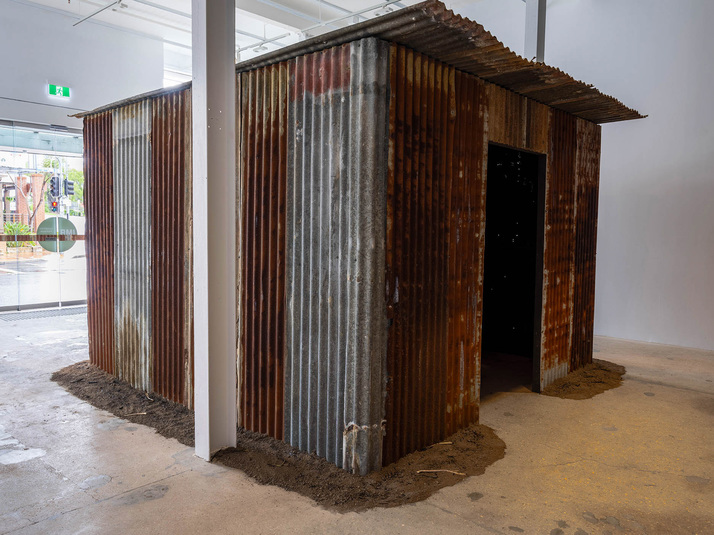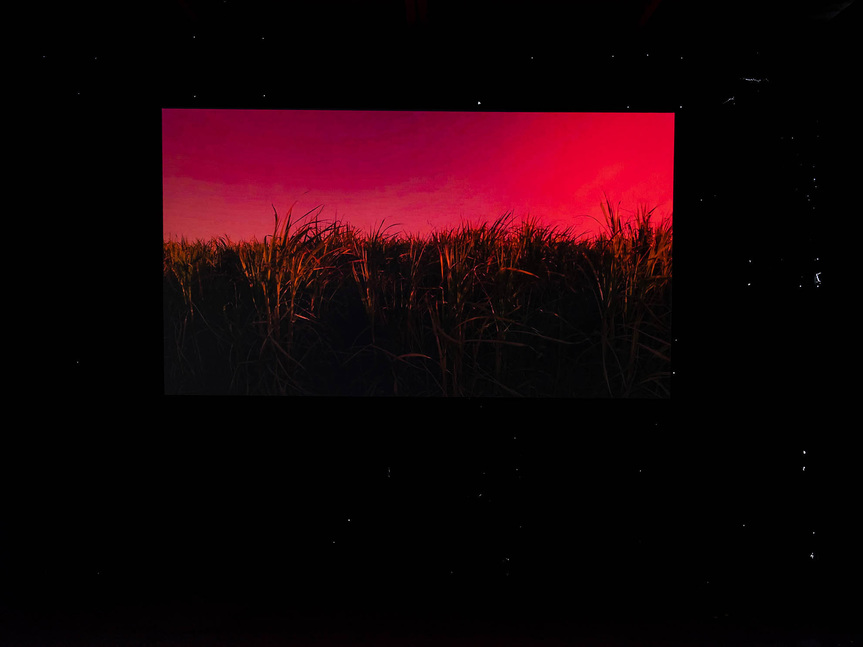-
From Current Issue
-
- Editor’s Letter Fire in the Heart
- Reviews I Gusti Ayu Kadek Murniasih
- Reviews 11th Seoul Mediacity Biennale: “One Escape at a Time”
- Dispatch Networked China
- One on One Monira Al Qadiri on Yukio Mishima
- Essays The rise of independent art spaces in pandemic-era Shanghai
- Features Tuan Andrew Nguyen
- Table of Contents
- Web Exclusives
- Archive
- Subscribe

R
E
V N
E
X
T
Installation view of SANCINTYA MOHINI SIMPSON’s Kortri, 2020, corrugated iron structure, wooden bench, soil, scent, dimensions variable; and Plantation, 2020, single-channel video projection: 14 min, at "Kūlī nām dharāyā / they’ve given you the name ‘coolie’,” IMA Belltower, Brisbane, 2020. Photo by Carl Warner. Courtesy the Institute of Modern Art (IMA), Brisbane.
Centered in the middle of IMA Belltower was a square structure of rusted iron: a room within a room, it was both a sculptural object and an encased film space. One could only enter the installation through a narrow doorway on the far wall, first bypassing the mounds of dry earth placed along the perimeter. Within the sheets of corrugated iron was a single-channel projection showing sugarcane bending against a red sky, accompanied by a female voice singing in East Indian Bihari dialect. Doubly enclosed, the room captured heat and moisture—leaving many viewers sweating—and carried the faint scent of dirt, burnt sugar, and incense.
Sancintya Mohini Simpson’s “Kūlī nām dharāyā / they’ve given you the name ‘coolie’” evoked the difficult lives of the two million Indian indentured servants (derogatorily called “coolies”) who were shipped across the British and French empires to work on sugar plantations in the 19th century. This often-overlooked chapter in colonial history is close to the artist, as her maternal family were contracted to a sugar plantation in Natal, then one of the four British colonies in South Africa. As explained in the exhibition guide, farmers from remote Indian villages were offered (or tricked into accepting) five-year contracts in the Pacific, Africa, and the Caribbean. A number of the surviving contracts are “signed” with a thumbprint, suggesting that many of these people could not write, let alone read the contracts written in English. Although “employees” by title, these workers were in effect slaves: they were paid negligible wages for exhausting hours, prohibited from leaving the plantation, and regularly assaulted by employers. While some returned to India, many of the workers in Natal were re-indentured and eventually settled around Durban.
This history is punctured by gaps, as many official documents lay hidden under layers of bureaucracy and family histories are veiled beneath generations of shame. Yet archival fragments survive. The installation’s sound component, Kūlī nām dharāyā (2020), stems from a folk verse passed down among families in Natal and later recorded by a linguist. Sung by Simpson’s mother, the video’s refrain translates to:
They’re given to the name “coolie,” they’ve given you the name “coolie”
You’ve come to Natal, give thanks in song, brother
With a cambu [food container] in your hand, and a hoe on your shoulder
Let the foreigners go home
Simpson asked viewers to reconsider colonial legacies in terms of smell and heat, of makeshift iron dwellings and languages spoken away from home. Comprising a number of materials—earth, rust, scent, moving image, and sound—her multipart installation creates a new, speculative record of indentured labor. Unlike the IMA’s concurrent exhibition, “CREATURE” by the English artist Marianna Simnett, Simpson needn’t force a sense of unease in her work. Horror already abounds in the subject. Her mother’s strained verses persisted in one’s mind, as did the sickly-sweet smell of burnt sugarcane.
Sancintya Mohini Simpson’s “Kūlī nām dharāyā / they’ve given you the name ‘coolie’” was scheduled to be on view at the IMA Belltower, Judith Wright Centre of Contemporary Arts, Brisbane, until April 18, 2020. Please check the exhibition web page for up-to-date information in light of Covid-19.
To read more of ArtAsiaPacific’s articles, visit our Digital Library.


















